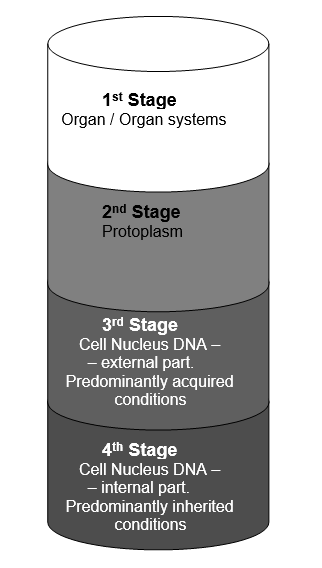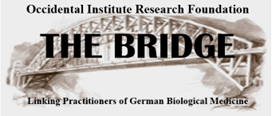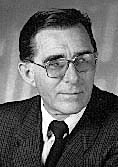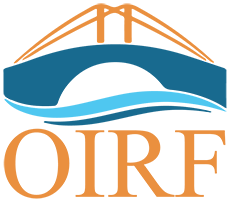Overview and New Developments (Part 3)
The Definition of Resonance Homeopathy
Resonance Homeopathy is an application of homeopathic medications developed in 1993/1994 according to resonance principles, which are assigned to organs, organ and cell structures as well as microorganisms (fungi, bacteria), on the basis of their corresponding resonance. Through oscillations of the cell membrane, toxins are eliminated and microorganisms are brought to a state of decay. In contrast to classical homeopathy (with remedy pictures), Resonance Homeopathy is applied based on a functional and clinical diagnosis.
Resonance Homeopathy is the application of homeopathic medications based on resonance principles and not according to the classical homeopathic rule “similia similibus” [1].
Discovery and Development of Resonance Homeopathy
The term “Resonance Homeopathy” was first introduced into medical literature in 1993 [2, 3]. Already before this time it was noticed from testing using the Vegetative Reflex Test (VRT), that repeatedly in certain organ illnesses homeopathic single remedies responded very strongly, as if they were nosodes. The working principle of nosodes is: “aequalia aequalibus”. This is similar to the vaccination principle, because pathogenic materials in higher dilution (here as potentiziations) are used in therapy, e.g. Diphtherinum nosode 8 X in the case of myocardial damage after recovering from diphtheria.
In addition, the application of nosodes also has to do with “resonance”, that means the nosode as a medication is in resonance with the damaged tissue – in this case myocardial damage. This explains also the occasionally very strong initial reactions in nosode therapy. A homeopathic substance with a nosode-like effect in the case of diphtheria caused myocardial damage is for example, Spartium scoparium [Cytisus scoparius]. One finds only a few references in the homeopathic literature about it, because homeopathy is founded on the principle “similia similibus”.
Then in the mid-1990’s, a first generation of homeopathic combination remedies were discovered which are therapeutically effective predominantly according to resonance principles and based less on the “Simile” law. Many classical homeopaths won’t like this, however due to their reliable effectiveness they can no longer be dismissed. The FM remedies created at that time proved themselves well and could still help many people with chronic illnesses, when everything else failed. Since the FM remedies can not be registered in Germany, utilization is limited by the “1000” rule [no more than a thousand bottles of each unregisterable remedy can be sold; WDS]. Furthermore, when using nosodes and these first generation resonance homeopathics an additional “drainage” with other phytopharmaceuticals or low potency homeopathics is necessary.
The Photon-Resonance-Test and its significance in Resonance Homeopathy
Approximately ten years later, the Photon-Resonance-Test (PRT) (see Fig. 1, [4]) successfully enabled conducting electroacupuncture testing right into the DNA of the cell nucleus, in order to track down the cause of many chronic illnesses existing there in the form of toxic microbial fragments1 [5]. The ability to test inside the cell nucleus DNA was a great advance, whose consequences are increasingly being recognized. The four stage classification utilized in this testing, has proven itself very well:
1 This term refers to toxins, fragments of bacteria, viruses, viroids, fungi, spores and parasites, as well as intact forms thereof, in addition to their immaterial programs, As long as these forms are not yet reduced to a zoological/biological denominator, I suggest leaving them with the name toxic microbial fragments”. (H.W. Schimmel)
Fig. 1: The four stages used in Photon- Resonance-Test diagnosis and therapy with “Resoplexes” (Resonance Homeopathics)”
Stage 1: Organs, organ systems with vessels and connective tissue (mesenchyme), e.g. organ systems such as central nervous system, peripheral nervous system, endocrine, lymph system, etc.
Stage 2: Cell plasma of organs and organ systems.
Stage 3: External part of cell nucleus DNA (Pentose phosphate pathway) of organs and organ systems; predominately acquired toxic microbial fragments, e.g. viruses or bacteria.
Stage 4: Internal part of cell nucleus DNA (hydrogen bonds between the purine bases [nucleotides]) of organs and organ systems; predominately inherited toxic microbial fragments as “miasmas”, e.g. viruses, bacteria.

Discovery of the Second Generation of Resonance Homeopathics – the “Resoplexes”
A second generation of Resonance Homeopathics – the “Resoplexes” 2 –developed from the observation that the diagnosis and elimination of toxic microbial fragments from the nucleus DNA was a great advance in the treatment of therapy resistant illnesses.
2 Information from:
Resolux GmbH.,
Affentalerstr. 49
77815 Bühl/Eisental, Germany
Telephone: (07223) 830 500
Fax: (07223) 830 501
Important characteristics of the Resoplexes and their differences to other homeopathics
The “Resoplex” series at present includes ten organ or organ system remedies, one remedy for fungal illnesses and one remedy for the treatment of precancerous [pre-malignant] states. As well, two snake venom combinations are available for treatment of clinical findings in the cell nucleus DNA.
The Resoplexes are characterized by the following qualities:
- Only two to three ingredients, which all however have resonance relationships with the indicated organs and organ systems or microorganisms, e.g. fungi and spores. Thus, with only two to three constituents a resonance effect is achieved with the organs, organ systems or microorganisms – however with higher efficiency, lower dosage and fewer initial reactions. Here for example, one could employ the model of the oscillating membrane, whereby toxins and fragments of pathogens, as well as the pathogens themselves are eventually removed from the membranes, or the micro- organisms disintegrate.
All organ or organ system remedies have both a resonance to the indicated organs and organ systems (Stage 1) as well as to the protoplasm of the cells (Stage 2) – see Figure 1. - Often therapy is necessary at Stage 3 and 4. Then tested snake venom combinations can be used, for example with the help of the Photon-Resonance-Test, Electro-acupuncture according to Voll, BFD, pulse diagnosis, kinesiology, etc. Snake venoms have a resonance relationship to the DNA, and because of that above all eliminate viral contamination within the DNA range. Due to separation of the snake venoms from the other homeopathic combinations and thus separate application of snake venoms, registration restrictions are avoided.
- Through separate application of the snake venoms they can be better and more individually dosed, which is not possible with predetermined mixtures. This applies particularly to the percutaneous application of the snake venoms, which are usually only given once or twice a week.
- Occasionally the application of snake venoms is not even necessary, if two or three suitable Resoplexes, possibly along with a lymph remedy (Resoplex 6), work on
- (Continued) Stage 3 and an effect similar to a snake venom develops in the DNA. Particularly with older patients the prescription of Resoplex 1 (liver) and Resoplex 4 (kidney) over several weeks, is sufficient to clear toxic microbial layers in Stages 3 and 4.
- Due to the relatively low potency of the Resoplex ingredients, generally no additional drainage remedies are necessary.
- An applicable nosode or homeopathic resonance remedy can be compared to the acquisition of a suitable target, because through the physical effect of the resonance the addressed cell and organ structures can, with repeated application, come into strong oscillatory states. Resonance homeopathics have such a high effectiveness, that with normal dosage even after some time, there is still a therapy reserve available.
Therefore overdosing should be avoided. That is much less an issue with other homeopathic combination remedies. The therapy reserves gained in this way can, with careful dosing, be meaningfully used for chronic illnesses. With therapeutically weak homeopathic combination remedies, such therapy reserves are missing. - With a one time dose of a tested snake venom combination in the high potency of 2000X, the reappraisal of psychogenic conflicts is made substantially easier, when Stage 4 was miasmatically burdened.
- In a time of increasing chronic illnesses we need homeopathic remedies with reliable therapeutic effectiveness. The practitioner is confronted more and more today with homeopathics whose effectiveness has been reduced by the interference of bureaucrats, e.g. mandated elimination of various ingredients.
Furthermore, the well-known “Simile” reactions occur less often today due to changed environmental conditions. Through integration of the resonance concept into classical homeopathy this can now be better scientifically investigated. Considering the speed of today’s scientific developments it will not be long, until the resonance principle will have attained a suitable status independent of the classical “similia similibus” rule.
 An exclusive article for Affiliates
An exclusive article for Affiliates
From THE BRIDGE Newsletter of OIRF
Published January 15, 2004
© Copyright 2003, 2004 by the Estate of Dr. H.W. Schimmel, Bühl-Eisental, Germany
Literature:
[1] Pschyrembel: Wörterbuch der Naturheilkunde, 2. Auflage. Berlin: Walter de Gruyter; 2000.
[2] Schimmel HW: Von der klassischen Homöopathie über die Komplex zur Resonanz-homöopathie. EHK 11/1993.
[3] Schimmel HW: Resonanzhomöopathie – eine Weiterentwicklung der klassischen Homöopathie. EHK 12/1994.
* [4] Schimmel HW: Miasmen und andere pathogene Informationen des Menschen (Teil 1). EHK 5/2002.
* [5] Schimmel HW: Pathogene Informationen in der DNS des Menschen als Ursache von chronischen Erkrankungen (Teil 2). EHK 11/2002.
* These are Parts 1 and 2, which preceded this concluding article (Part 3). O.I.R.F. has not translated them, since their substance is covered in reports and material already provided to Affiliates; WDS. For further German language literature refer to:
Schimmel HW: Viren – eine unterschätzte Bedrohung. EHK 11/2000.
Schimmel HW: Der Photonen-Resonanz-Test, eine innovative Ergänzung der Elektroakupunktur. EHK 9/2001.
Correspondence address: Dr. Frederic Sauvage, Arzt und Apotheker, Affentalerstr. 49, 77815 Bühl-Eisental, Germany



